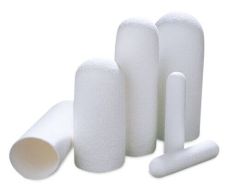Close
BRYANT & BURKEY BASE BROTH (modified with resarzurine) 500 grams/bottle
SKU
CDL/1247
Brand
CONDALAB
Pre-order (Deliver in 8 to 12 weeks)
Bryant-Burkey Broth Base (Modified with Resazurin) is used for the enumeration of spores of lactate fermenting Clostridia in milk and dairy products, particularly Clostridium tyrobutyricum. This bacterium is the one that causes the swelling of cheeses.
During milking process small numbers of butyric acid fermenting bacteria are introduced into the raw milk. When the contaminated milk is used for producing cheese, the brines become contaminated with heat resistant Clostridia spores. During the ripening of salt brined, semi- and hard cheeses, (for example, Gouda, Edamm, Emmental, Gruyere, and Parmesan) late blowing gasogenic Clostridia ferment lactate into butyric acid, acetic acid and gas (CO2 and H2). The gas expands the cheese and causes a defect known as "late blowing" or butyric swelling.
The medium does not contain lactate so it must be added when the medium is prepared. Sodium lactate is fermented under anaerobic conditions by C. tyrobutyricum and other lactate-fermenting Clostridia and uses it as a source of carbon and energy, producing hydrogen and CO2. Tryptone and beef extract provide nitrogen, vitamins, minerals and amino acids essential for growth. Yeast extract is a source of vitamins, particularly of the B-group essential for bacterial growth. Sodium acetate is the selective agent inhibiting gram-negative bacteria and also promotes the growth of C. tyrobutyricum. L-Cysteine is the reducing agent and resazurin is an oxidation indicator, turning from pink (aerobic) to colorless (under anaerobic conditions).
Bryant-Burkey Broth Base (Modified with Resazurin) is used for the enumeration of spores of lactate fermenting Clostridia in milk and dairy products, particularly Clostridium tyrobutyricum. This bacterium is the one that causes the swelling of cheeses.
During milking process small numbers of butyric acid fermenting bacteria are introduced into the raw milk. When the contaminated milk is used for producing cheese, the brines become contaminated with heat resistant Clostridia spores. During the ripening of salt brined, semi- and hard cheeses, (for example, Gouda, Edamm, Emmental, Gruyere, and Parmesan) late blowing gasogenic Clostridia ferment lactate into butyric acid, acetic acid and gas (CO2 and H2). The gas expands the cheese and causes a defect known as "late blowing" or butyric swelling.
The medium does not contain lactate so it must be added when the medium is prepared. Sodium lactate is fermented under anaerobic conditions by C. tyrobutyricum and other lactate-fermenting Clostridia and uses it as a source of carbon and energy, producing hydrogen and CO2. Tryptone and beef extract provide nitrogen, vitamins, minerals and amino acids essential for growth. Yeast extract is a source of vitamins, particularly of the B-group essential for bacterial growth. Sodium acetate is the selective agent inhibiting gram-negative bacteria and also promotes the growth of C. tyrobutyricum. L-Cysteine is the reducing agent and resazurin is an oxidation indicator, turning from pink (aerobic) to colorless (under anaerobic conditions).
| Brand | CONDALAB |
|---|
Write Your Own Review









Validate your login